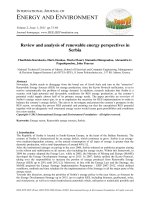genetics principles and analysis - daniel l. hartl
Bạn đang xem bản rút gọn của tài liệu. Xem và tải ngay bản đầy đủ của tài liệu tại đây (24.52 MB, 1,367 trang )
Page i
Genetics:
Principles and Analysis
Fourth Edition
Daniel L. Hartl
Harvard University
Elizabeth W. Jones
Carnegie Mellon University
Page ii
TO THE BEST TEACHERS WE EVER HAD—OUR PARENTS AND OUR STUDENTS
ABOUT THE AUTHORS
Daniel L. Hartl
is a Professor of Biology at Harvard University. He received his B.S. degree and
Ph.D. from the University of Wisconsin. His research interests include molecular genetics,
molecular evolution, and population genetics.
Elizabeth W. Jones
is a Professor of Biological
Sciences at Carnegie Mellon University. She received her B.S. degree and Ph.D. from the
University of Washington in Seattle. Her research interests include gene regulation and the genetic
control of cellular form. Currently she is studying the function and assembly of organelles in the
yeast
Saccharomyces.
ABOUT THE COVER
A human chromosome.
ABOUT THE PUBLISHER
World Headquarters
Jones and Bartlett Publishers
40 Tall Pine Drive
Sudbury, MA 01776
978-443-5000
Jones and Bartlett Publishers Canada
P.O. Box 19020
Toronto, ON M5S 1X1
CANADA
Jones and Bartlett Publishers International
Barb House, Barb Mews
London W6 7PA
UK
ABOUT THE BOOK
Chief Executive Officer:
Clayton Jones
Chief Operating Officer:
Don Jones, Jr.
Publisher:
Tom Walker
V.P., Sales and Marketing:
Rob McCarry
Senior Managing Editor:
Judith H. Hauck
Marketing Director:
Rich Pirozzi
Production Manager:
Anne Spencer
Manufacturing Director:
Jane Bromback
Executive Editor:
Brian L. McKean
Project Editor:
Kathryn Twombly
Senior Production Editor:
Mary Hill
Web Site Design:
Andrea Wasik
* * *
Development Editor:
Richard Morel
Book and Cover Design:
J/B Woolsey Associates
Art Development and Rendering:
J/B Woolsey Associates
Composition and Book Layout:
Thompson Steele, Inc.
Prepress:
Westwords, Inc.
Cover Manufacture:
Coral Graphic Services, Inc.
Book Manufacture:
World Color Book Services
Library of Congress Cataloging-in-Publication Data
Hartl, Daniel L.
Genetics: Principles and analysis / Daniel L. Hartl, Elizabeth W. Jones.—4th ed.
p. cm.
Includes bibliographical references (p.).
ISBN 0-7637-0489-X
1. Genetics. I. Jones, Elizabeth W. II. Title.
QH430.H3733 1998
576.5—dc21 97-40566
CIP
COPYRIGHT
1998 BY JONES AND BARTLETT PUBLISHERS, INC.
All rights reserved. No part of the material protected by this copyright notice may be reproduced or
utilized in any form, electronic or mechanical, including photocopying, recording, or by any
information storage and retrieval system, without written permission from the copyright owner.
Printed in the United States
03 02 01 00 99 98 9 8 7 6 5 4 3 2
Page iii
Brief Contents
Chapter 1
The Molecular Basis of Heredity and Variation
1
Chapter 2
Principles of Genetic Transmission
30
Chapter 3
Genes and Chromosomes
80
Chapter 4
Genetic Linkage and Chromosome Mapping
122
Chapter 5
The Molecular Structure and Replication of the Genetic Material
172
Chapter 6
The Molecular Organization of Chromosomes
220
Chapter 7
Variation in Chromosome Number and Structure
258
Chapter 8
The Genetics of Bacteria and Viruses
306
Chapter 9
Genetic Engineering and Genome Analysis
358
Chapter 10
Gene Expression
410
Chapter 11
Regulation of Gene Activity
458
Chapter 12
The Genetic Control of Development
510
Chapter 13
Mutation, DNA Repair, and Recombination
554
Chapter 14
Extranuclear Inheritance
598
Chapter 15
Population Genetics and Evolution
626
Chapter 16
Quantitative Genetics and Multifactorial Inheritance
668
Chapter 17
Genetics of Biorhythms and Behavior
702
Page iv
Contents
Preface
xv
Introduction: For the Student
xxi
Chapter 1
The Molecular Basis of Heredity and Variation
1
1-1 DNA: The Genetic Material
2
Experimental Proof of the Genetic Function of DNA
3
Genetic Role of DNA in Bacteriophage
6
1-2 DNA Structure: The Double Helix
9
1-3 An Overview of DNA Replication
10
1-4 Genes and Proteins
12
Transcription of DNA Makes RNA
12
Translation of RNA Makes Protein
14
1-5 Mutation
15
1-6 How Genes Determine Traits
16
Pleiotropy: One Gene Can Affect More Than One Trait
17
Epistasis: One Trait Can Be Affected by More Than One Gene
19
Effects of the Environment
20
1-7 Evolution
22
The Molecular Continuity of Life
22
Adaptation and Diversity
23
The Role of Chance in Evolution
24
Chapter End Material
Chapter Summary
24
Key Terms
25
Review the Basics
26
Guide to Problem Solving
26
Analysis and Applications
28
Further Reading
29
Special Features
Connection: It's the DNA!
Oswald T. Avery, Colin M. MacLeod,
and Maclyn McCarty 1944
Studies on the chemical nature of the substance inducing
transformation of pneumococcal types
4
Connection: Shear Madness
Alfred D. Hershey and Martha Chase 1952
Independent functions of viral protein and nucleic acid in
growth of bacteriophage
8
GeNETics on the Web
27
Chapter 2
Principles of Genetic Transmission
30
2-1 The Monohybrid Crosses
32
Traits Present in the Progeny of the Hybrids
35
Mendel's Genetic Hypothesis and Its Experimental Tests
36
The Principle of Segregation
40
Important Genetic Terminology
40
Verification of Mendelian Segregation by the Testcross
41
2-2 Segregation of Two or More Genes
42
The Principle of Independent Assortment
42
Dihybrid Testcrosses
45
The Big Experiment
45
2-3 Mendelian Inheritance and Probability
48
Mutually Exclusive Events: The Addition Rule
48
Independent Events: The Multiplication Rule
49
2-4 Segregation in Human Pedigrees
51
2-5 Genetic Analysis
54
The Complementation Test in Gene Identification
54
Why Does the Complementation Test Work?
58
Multiple Alleles
60
2-6 Modified Dihybrid Ratios Caused by Epistasis
61
2-7 Complications in the Concept of Dominance
64
Amorphs, Hypomorphs, and Other Types of Mutations
66
Incomplete Dominance
67
Codominance and the Human ABO Blood Groups
68
Incomplete Penetrance and Variable Expressivity
70
Chapter End Material
Chapter Summary
72
Key Terms
73
Review the Basics
73
Guide to Problem Solving
73
Analysis and Applications
76
Challenge Problems
78
Further Reading
79
Special Features
Connection: What Did Gregor Mendel Think He Discovered
Gregor Mendel 1866
Experiments on plant hybrids
38
Connection: This Land Is Your Land, This Land Is My Land
The Huntington's Disease Collaborative Research Group 1993
A novel gene containing a trinucleotide repeat that is expanded
and unstable on Huntington's disease chromosome
53
GeNETics on the Web
74
Page v
Chapter 3
Genes and Chromosomes
80
3-1 The Stability of Chromosome Complements
82
3-2 Mitosis
83
3-3 Meiosis
87
The First Meiotic Division: Reduction
89
The Second Meiotic Division: Equation
94
3-4 Chromosomes and Heredity
96
Chromosomal Determination of Sex
97
X-linked Inheritance
97
Nondisjunction As Proof of the Chromosome Theory of Heredity
103
Sex Determination in Drosophila
104
3-5 Probability in Prediction and Analysis of Genetic Data
106
Using the Binomial Distribution in Genetics
106
Evaluating the Fit of Observed Results to Theoretical Expectations
109
The Chi-Square Method
109
3-6 Are Mendel's Data Too Good to Be True?
114
Chapter End Material
Chapter Summary
115
Key Terms
116
Review the Basics
117
Guide to Problem Solving
117
Analysis and Applications
119
Challenge Problems
121
Further Reading
121
Special Features
Connection: Grasshopper, Grasshopper
E. Eleanor Carothers 1913
The Mendelian ratio in relation to certain Orthopteran
chromosomes
96
Connection: The White-Eyed Male
Thomas Hunt Morgan 1910
Sex limited inheritance in Drosophila
101
Connection: The Case Against Mendel's Gardener
Ronald Aylmer Fisher 1936
Has Mendel's work been rediscovered?
112
GeNETics on the Web
118
Chapter 4
Genetic Linkage and Chromosome Mapping
122
4-1 Linkage and Recombination of Genes in a Chromosome
124
4-2 Genetic Mapping
127
Crossing-over
132
Crossing-over Takes Place at the Four-Strand Stage of Meiosis
134
The Molecular Basis of Crossing-over
137
Multiple Crossing-over
138
4-3 Gene Mapping from Three-Point Testcrosses
141
Chromosome Interference in Double Crossing-over
143
Genetic Mapping Functions
144
Genetic Distance and Physical Distance
145
4-4 Genetic Mapping in Human Pedigrees
146
4-5 Mapping by Tetrad Analysis
150
The Analysis of Unordered Tetrads
151
The Analysis of Ordered Tetrads
154
4-6 Mitotic Recombination
158
4-7 Recombination Within Genes
160
4-8 A Closer Look at Complementation
161
Chapter End Material
Chapter Summary
162
Key Terms
163
Review the Basics
164
Guide to Problem Solving
164
Analysis and Applications
167
Challenge Problems
170
Further Reading
171
Special Features
Connection: Genes All in a Row
Alfred H. Sturtevant 1913
The linear arrangement of six sex-linked factors in Drosophila,
as shown by their mode of association
131
Connection: Dos XX
Lilian V. Morgan 1922
Non-crisscross inheritance in Drosophila Melanogaster
137
GeNETics on the Web
164
Page vi
Chapter 5
The Molecular Structure and Replication of the Genetic Material
172
5-1 The Chemical Composition of DNA
174
5-2 The Physical Structure of the Double Helix
177
5-3 What a Genetic Material Needs That DNA Supplies
181
5-4 The Replication of DNA
182
The Basic Rule for the Replication of Nucleic Acids
182
The Geometry of DNA Replication
183
5-5 DNA Synthesis
191
5-6 Discontinuous Replication
194
Fragments in the Replication Fork
194
Initiation by an RNA Primer
195
The Joining of Precursor Fragments
196
Other Proteins Needed for DNA Replication
196
5-7 The Isolation and Characterization of Particular DNA Fragments
199
Denaturation and Renaturation
199
Nucleic Acid Hybridization
200
Restriction Enzymes and Site-Specific DNA Cleavage
202
Gel Electrophoresis
205
The Southern Blot
206
5-8 The Polymerase Chain Reaction
207
5-9 Determination of the Sequence of Bases in DNA
210
The Sequencing Procedure
212
Clinical Use of Dideoxynucleoside Analogs
213
Chapter End Material
Chapter Summary
214
Key Terms
214
Review the Basics
215
Guide to Problems Solving
215
Analysis and Applications
216
Challenge Problems
218
Further Reading
219
Special Features
Connection: The Double Helix
James D. Watson and Francis H. C. Crick 1953
A structure for deoxyribose nucleic acid
180
Connection: Replication by Halves
Matthew Meselson and Franklin W. Stahl 1958
The replication of DNA in Escherichia coli
184
GeNETics on the Web
217
Chapter 6
The Molecular Organization of Chromosomes
220
6-1 Genome Size and Evolutionary Complexity
222
6-2 The Supercoiling of DNA
224
Topoisomerase Enzymes
225
6-3 The Structure of the Bacterial Chromosome
225
6-4 The Structure of Eukaryotic Chromosomes
228
The Nucleosome Is the Basic Structural Unit of Chromatin
228
Nucleosome Core Particles
229
The Arrangement of Chromatin Fibers in a Chromosome
230
6-5 Polytene Chromosomes
234
6-6 Repetitive Nucleotide Sequences in Eukaryotic Genomes
235
Kinetics of DNA Renaturation
236
Analysis of Genome Size and Repetitive Sequences by
Renaturation
238
6-7 Nucleotide Sequence Composition of Eukaryotic Genomes
239
Unique Sequences
240
Highly Repetitive Sequences
240
Middle-Repetitive Sequences
241
6-8 Transposable Elements
242
6-9 Centromere and Telomere Structure
246
Molecular Structure of the Centromere
246
Molecular Structure of the Telomere
247
Chapter End Material
Chapter Summary
253
Key Terms
253
Review the Basics
254
Guide to Problem Solving
254
Analysis and Applications
255
Challenge Problem
256
Further Reading
257
Special Features
Connection: Her Feeling for the Organism
Barbara McClintock 1950
The origin and behavior of mutable loci in maize
245
Connection: Telomeres: The Beginning of the End
Carol W. Greider and Elizabeth H. Blackburn 1987
The telomere terminal transferase of Tetrahymena is a
ribonucleoprotein enzyme with two kinds of primer specificity
249
GeNETics on the Web
256
Page vii
Chapter 7
Variation in Chromosome Number and Structure
258
7-1 Centromeres and the Genetic Stability of Chromosomes
260
7-2 Polyploidy
261
7-3 Monoploid Organisms
266
7-4 Extra or Missing Chromosomes
267
7-5 Human Chromosomes
269
Trisomy in Human Beings
274
Dosage Compensation
274
The Calico Cat As Evidence for X-Chromosome Inactivation
277
Sex-Chromosome Abnormalities
278
The Fragile-X Syndrome
279
Chromosome Abnormalities in Spontaneous Abortion
280
7-6 Abnormalities in Chromosome Structure
281
Deletions
281
Duplications
282
Unequal Crossing-Over in Human Red-Green Color Blindness
283
Inversions
286
Reciprocal Translocations
288
Robertsonian Translocations
293
7-7 Position Effects on Gene Expression
296
7-8 Chromosome Abnormalities and Cancer
297
Retinoblastoma and Tumor-Suppressor Genes
298
Chapter End Material
Chapter Summary
300
Key Terms
300
Review the Basics
301
Guide to Problem Solving
301
Analysis and Applications
302
Challenge Problems
305
Further Reading
305
Special Features
Connection: The First Human Chromosomal Disorder
Jerome Lejeune, Marthe Gautier, and Raymond Turpin 1959
Study of the somatic chromosomes of nine Down syndrome
children
271
Connection: Lyonization of an X Chromosome
Mary F. Lyon 1961
Gene action in the X chromosome of the mouse (Mus musculus
L.)
276
GeNETics on the Web
303
Chapter 8
The Genetics of Bacteria and Viruses
306
8-1 The Genetic Organization of Bacteria and Viruses
308
8-2 Bacterial Mutants
311
8-3 Bacterial Transformation
312
8-4 Conjugation
314
Plasmids
314
Hfr Cells
317
Time-of-Entry Mapping
319
F' Plasmids
324
8-5 Transduction
325
8-6 Bacteriophage Genetics
329
Plaque Formation and Phage Mutants
330
Genetic Recombination in Virulent Bacteriophages
331
Fine Structure of the rII Gene in Bacteriophage T4
336
8-7 Genetic Recombination in Temperate Bacteriophages
340
Lysogeny
340
Specialized Transducing Phage
345
8-8 Transposable Elements
346
Transposons in Genetic Analysis
349
Chapter End Material
Chapter Summary
350
Key Terms
351
Review the Basics
352
Guide to Problem Solving
352
Analysis and Applications
353
Challenge Problems
356
Further Reading
357
Special Features
Connection: The Sex Life of Bacteria
Joshua Lederberg and Edward L. Tatum 1946
322
Gene recombination in Escherichia coli
Connection: Is a Bacteriophage an "Organism"?
Alfred D. Hershey and Raquel Rotman 1948
Genetic recombination between host-range and plaque-type
mutants of bacteriophage in single bacterial cells
329
Connection: Artoo
Seymour Benzer 1955
Fine structure of a genetic region in bacteriophage
334
GeNETics on the Web
354
Page viii
Chapter 9
Genetic Engineering and Genome Analysis
358
9-1 Restriction Enzymes and Vectors
360
Production of Defined DNA Fragments
360
Recombinant DNA Molecules
362
Plasmid, Lambda, Cosmid, and P1 Vectors
365
9-2 Cloning Strategies
365
Joining DNA Fragments
366
Insertion of a Particular DNA Molecule into a Vector
366
The Use of Reverse Transcriptase: cDNA and RT-PCR
369
Detection of Recombinant Molecules
370
Screening for Particular Recombinants
372
Positional Cloning
372
9-3 Site-Directed Mutagenesis
374
9-4 Reverse Genetics
377
Germ-Line Transformation in Animals
377
Genetic Engineering in Plants
380
9-5 Applications of Genetic Engineering
382
Giant Salmon with Engineered Growth Hormone
382
Engineered Male Sterility with Suicide Genes
383
Other Commercial Opportunities
384
Uses in Research
386
Production of Useful Proteins
386
Genetic Engineering with Animal Viruses
387
Diagnosis of Hereditary Diseases
388
9-6 Analysis of Complex Genomes
388
Sizes of Complex Genomes
388
Manipulation of Large DNA Fragments
390
Cloning of Large DNA Fragments
390
Physical Mapping
392
The Genome of E. coli
395
The Human Genome
395
Genome Evolution in the Grass Family
398
9-7 Large-Scale DNA Sequencing
400
Complete Sequence of the Yeast Genome
400
Automated DNA Sequencing
401
Chapter End Material
Chapter Summary
405
Key Terms
406
Review the Basics
406
Guide to Problem Solving
406
Analysis and Applications
407
Challenge Problems
409
Further Reading
409
Special Features
Connection: Hello, Dolly!
Ian Wilmut, Anagelika E. Schnieke, Jim McWhir, Alex J. Kind,
and Keith H. S. Campbell 1997
Viable offspring derived from fetal and adult mammalian cells
380
Connection: YAC-ity YAC
David T. Burke, Georges F. Carle and Maynard V. Olson 1987
Cloning of large segments of exogenous DNA into yeast by
means of artificial chromosome vectors
393
GeNETics on the Web
408
Chapter 10
Gene Expression
410
10-1 Proteins and Amino Acids
412
10-2 Relations between Genes and Polypeptides
415
What Are the Minimal Genetic Functions Needed for Life?
416
10-3 Transcription
418
General Features of RNA Synthesis
418
Messenger RNA
423
10-4 RNA Processing
424
Termination
436
Monocistronic and Polycistronic mRNA
436
10-5 Translation
430
Initiation
431
Elongation
433
Termination
436
Monocistronic and Polycistronic mRNA
436
Chapter End Material
Chapter Summary
452
Key Terms
453
Review the Basics
453
Guide to Problem Solving
453
Analysis and Applications
455
Challenge Problems
457
Further Reading
457









